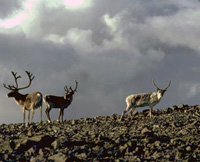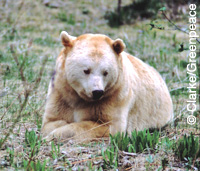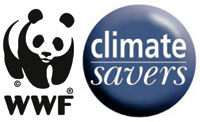
News |
- Manitoba Fails Green Report Card
- Ottawa Sued for Loosening Environmental Rules
- Environmental Groups Fight for Killer Whales
- Greenhouse Gases Threaten Human Health: EPA
- International Migratory Bird Day - May 9th
- West Virginian Wins Goldman Award
- Quebec Protects 4.5 Million Boreal Acres
- International Program Partners with First Nations
- Groups Attack NDP Stand on Carbon Tax
- Woodland Caribou Habitat Needs Protection
- B.C. Protects Great Bear Rainforest
- Climate Savers Cut Emissions
| Manitoba Fails Green Report Card | 11 May 09 |
 Manitoba received a F-level grade in the April 2009 Green Provincial Report Card issued by Corporate Knights. The group ranked the provinces and territories according to 10 environmental categories including greenhouse gasses, green energy, water use, biodiversity, and car dependency. Manitoba received a F-level grade in the April 2009 Green Provincial Report Card issued by Corporate Knights. The group ranked the provinces and territories according to 10 environmental categories including greenhouse gasses, green energy, water use, biodiversity, and car dependency.The research was conducted through online research, government websites and expert interviews. At the top of the class was British Columbia, with an individual grade of 69% thanks to green jobs, buildings, energy efficiency, and organic food. Prince Edward Island was dead last with a score of 32%. "Our hope is that this clear presentation of provincial eco-performance will be seized upon by leaders across Canada looking to ramp up their region's eco-resiliency," said Toby Heaps, the editor-in-chief of Corporate Knights. Manitoba placed ninth among 13 Canadian jurisdictions, ranking low in everything but energy - where it got an A+ for total energy consumed per GDP. Manitoba tied with Saskatchewan for the lowest environmental employment and organic food consumed. View Corporate Knights - Green Provincial Report 2009View April 22, 2009 Corporate Knights press release View April 22, 2009 CTV article View April 22, 2009 Winnipeg Free Press article View April 21, 2009 Canadian Press article Sources: Corporate Knights, CTV, Winnipeg Free Press |
|
 Print version Print version |
Top |
| Ottawa Sued for Loosening Environmental Rules | 11 May 09 |
 Canada's federal government issued regulations that would exempt about 2,000 federally funded infrastructure projects from having to pass environmental assessments, all in an effort to seek faster economic benefits, from the current economic stimulus package. Canada's federal government issued regulations that would exempt about 2,000 federally funded infrastructure projects from having to pass environmental assessments, all in an effort to seek faster economic benefits, from the current economic stimulus package.Ecojustice filed a lawsuit on behalf of Sierra Club of Canada claiming the federal Cabinet does not have authority to issues regulations under the Canadian Environmental Assessment Act (CEAA). The lawsuit asks the Federal Court to declare the two recent regulations illegal, they are: The Exclusion List Regulations would exempt projects such as highways, bridges, garbage dumps, sewer systems, funded under the Building Plan Canada, from legally required federal assessments, until March 2011. The Infrastructure Projects Environmental Adaptation Regulations would unlawfully give powers to the Minister of Environment to exempt other projects from a federal EA funded under the Building Canada Fund. "It is reckless, irresponsible and represents an extremely serious attack on Canada's environmental assessment laws. US, China or India have not gotten rid of environmental assessment oversight in their economic stimulus plans," said Ecojustice lawyer Justin Duncan. View April 20, 2009 Sierra Club Canada articleView March 19, 2009 Canadian Environmental Assessment Act - Regulation Amendments (PDF) View April 15, 2009 Sierra Club of Canada's Notice of Application (PDF) View April 28, 2009 video of Sierra Club Canada Executive Director at Senate Committee View April 20, 2009 CBC article View April 23, 2009 Canadian Press article View April 20, 2009 Globe and Mail article Sources: Sierra Club, Canada Gazette, CBC |
|
 Print version Print version |
Top |
| Environmental Groups Fight for Killer Whales | 11 May 09 |
 Canada's Department of Fisheries and Ocean (DFO) is trying to have a lawsuit that seeks legal protection for killer whales, thrown out of court. DFO claims an Order under the Species at Risk Act (SARA) filed in February 2009 will protect the endangered orcas. Canada's Department of Fisheries and Ocean (DFO) is trying to have a lawsuit that seeks legal protection for killer whales, thrown out of court. DFO claims an Order under the Species at Risk Act (SARA) filed in February 2009 will protect the endangered orcas.Ecojustice filed the lawsuit on behalf of nine of Canada and British Columbia's leading environmental organizations alleging that DFO failed to protect the critical habitat of Northern and Southern resident killer whales in the Pacific Northwest, as required by law. Environmental groups welcomed the precedent-setting Order but still want their case to be heard to ensure the government takes action under SARA. They are concerned the Order focuses on protecting the geophysical features of critical habitat only and does not address declining food sources, pollution, vessel traffic and acoustic disturbances. If the case is successful, SARA will be required to protect critical habitat of all endangered aquatic species. View April 20, 2009 Ecojustice press releaseView February 25, 2009 Ecojustice press release View April 20, 2009 Canadian Press article View May 1, 2009 CBC article Sources: Ecojustice, Canadian Press |
|
 Print version Print version |
Top |
| Greenhouse Gases Threaten Human Health: EPA | 11 May 09 |
 Carbon dioxide and other greenhouse gas emissions represent a significant threat to public health and human welfare. The United States Environmental Protection Agency (EPA) issued the finding two years after the U.S. Supreme Court ordered a scientific review. Carbon dioxide and other greenhouse gas emissions represent a significant threat to public health and human welfare. The United States Environmental Protection Agency (EPA) issued the finding two years after the U.S. Supreme Court ordered a scientific review. The EPA analyzed six greenhouse gasses and concluded their concentrations are at historic levels due to human activity. The EPA now has authority and obligation to regulate global warming pollution under the U.S. Clean Air Act. President Obama has committed to building a green economy and the Sierra Club US has launched "The Big Picture" campaign to mobilize support for the rules and regulations expected to follow the "endangerment finding". View EPA Proposed Endangerment and Cause or Contribute Findings for Greenhouse Gases Under the Clean Air Act (PDF)View EPA Background View April 17, 2009 EPA press release View April 17, 2009 Sierra Club press release View Sierra Club, The Big Picture: Help Obama Build Our Clean Energy Future View April 17, 2009 Green Biz article Sources: US EPA, Sierra Club, Green Biz |
|
 Print version Print version |
Top |
| International Migratory Bird Day - May 9th | 07 May 09 |
 Join May 9th to celebrate migratory birds and their spectacular journey between their breeding grounds in North America and wintering grounds in Mexico, Central, and South America. Join May 9th to celebrate migratory birds and their spectacular journey between their breeding grounds in North America and wintering grounds in Mexico, Central, and South America. This year's theme for the International Migratory Bird Day (IMBD) is 'Celebrating Birds in Culture' which explores the role birds play in the lives of Native People throughout the Americas. Birds have been represented in tribal life since ancient times in cave art, weavings, pottery, stories, ceremonies, and as a source of food. Started in 1993, IMBD is the premier education project of Environment for the Americas. The event encourages bird conservation and increases awareness of birds through hikes, bird watching, public events, and other educational programs. View International Migratory Bird Day websiteView IMBD Explorer's Map View Nature Canada - Bird Conservation View Bird Conservation & Native Cultures (PDF) Sources: International Migratory Bird Day website, Nature Canada |
|
 Print version Print version |
Top |
| West Virginian Wins Goldman Award | 07 May 09 |
 Maria Gunnoe's work to stop the devastating practice of mountaintop removal coal mining has shut down mines and led to stricter regulations. Now Maria Gunnoe is among the 2009 recipients of the Goldman Environmental Prize. Maria Gunnoe's work to stop the devastating practice of mountaintop removal coal mining has shut down mines and led to stricter regulations. Now Maria Gunnoe is among the 2009 recipients of the Goldman Environmental Prize. A born-and-bred West Virginian, Gunnoe has worked with the Ohio Valley Environmental Coalition, as well as Sierra Club's Environmental Law and Environmental Justice programs, to stop a mining practice that devastates communities and natural resources. As she says in a Goldman video, "When you flip a switch on, there's a 52% chance that you're destroying the water, air, and land where I live." Other 2009 Goldman Prize winners hail from Gabon, Suriname, Bangladesh, Russia, and Indonesia. Each receives $150,000 to pursue his or her vision of a renewed and protected environment. View Maria Gunnoe biographyView Sierra Club US program to stop mountain top removal View all 2009 Goldman Environmental Prize winners Sources: Sierra Club, Goldman Prize |
|
 Print version Print version |
Top |
| Quebec Protects 4.5 Million Boreal Acres | 07 May 09 |
 The Quebec government has protected an additional 18,000 square kilometers or 4.5 million acres of Canada's boreal forests. The Quebec government has protected an additional 18,000 square kilometers or 4.5 million acres of Canada's boreal forests. In 2003 Quebec set a goal to protect 8 percent of the province, the latest addition brings the total 8.12 percent or 135,326 square kilometers. Quebec has committed to adding another four percent province-wide and to protect at least half of northern Quebec as part of Plan Nord. "Just five years ago, Quebec was behind in protecting its natural heritage. Now it's on its way to becoming a world leader," said Mathew Jacobson of the Pew Environmental Group. "With each new conservation addition, Quebec emerges further as a global model for sustainable economic development and land conservation." Environmental groups applauded the move to protect one of the largest intact forest and wetland ecosystems remaining on earth. Canada's Boreal Forest stores 186 billion tones of carbon and provides nesting grounds for billions of songbirds and waterfowl. "Manitobans have been waiting for years for their government to take steps like Quebec is taking. Our boreal forest regions urgently need new protected areas," commented Gaile Whelan Enns of Manitoba Wildlands. View March 30, 2009 Montreal Gazette articleView March 29, 2009 PEW Charitable Trusts release View March 29, 2009 Boreal Canada article View March 30, 2009 Boreal Songbirds Initiative release View April 1, 2009 Tree Hugger article Sources: The Montreal Gazette, Pew Charitable Trusts, Boreal Song Bird Initiative |
|
 Print version Print version |
Top |
| International Program Partners with First Nations | 06 May 09 |
 The Jane Goodall Institute has partnered with Canada's Assembly of First Nations to bring the global youth program, Roots & Shoots to First Nation communities across Canada. AFN National Chief Phil Fontaine sees the program as a way to inspire young people and reduce poverty by encouraging youth to be the vehicles of change in their communities. The Jane Goodall Institute has partnered with Canada's Assembly of First Nations to bring the global youth program, Roots & Shoots to First Nation communities across Canada. AFN National Chief Phil Fontaine sees the program as a way to inspire young people and reduce poverty by encouraging youth to be the vehicles of change in their communities."Roots & Shoots is a program aimed at getting young people involved in developing their own projects to improve the environment, gain a greater understanding of their culture, and improve lives of the people in their communities," said Fontaine. Roots & Shoots is an environmental and humanitarian education program that empowers youth to make positive changes in their communities. The program includes a global network of more than 100,000 youth in almost 100 countries. There are already two First Nations communities in British Columbia involved in Roots & Shoots. The Jane Goodall Institute will work closely with AFN to expand the program to other interested First Nation communities. Visit Roots & Shoots - CanadaView April 15, 2009 Assembly of First Nations press release (PDF) View April 15, 2009 Canoe News article View April 16, 2009 Ottawa Citizen article Sources: Jane Goodall Institute of Canada, Assembly of First Nations, Canoe News, Ottawa Citizen |
|
 Print version Print version |
Top |
| Groups Attack NDP Stand on Carbon Tax | 06 May 09 |
 The David Suzuki Foundation, the Pembina Institute and Forest Ethics condemned a New Democratic Party promise to drop the first-ever carbon tax in North American. The David Suzuki Foundation, the Pembina Institute and Forest Ethics condemned a New Democratic Party promise to drop the first-ever carbon tax in North American. B.C. implemented the carbon tax July 2008 under the Liberal government but NDP leader Carole James promises to axe the tax as part of her party's platform for the May 12 B. C. election. James says it is "the wrong tax at the wrong time," and that a cap-and-trade system will distribute the burden more fairly on large-scale polluters. "The NDP has chosen what they think will be a publicly acceptable but climate-irresponsible approach. And that is, they want to step backward on the pricing of carbon and backwards on the policies in place in the hopes that may get them elected," Merran Smith, a climate director with ForestEthics, said Monday. Environmental critics say the NDP plan could cost the province thousands of jobs in the green economy, loose its position as an environmental leader and simply delay urgently needed action on climate change. View April 13, 2009 DeSmog Blog articleView April 9, 2009 Pembina Institute press release View April 16, 2009 Times Columnist article View April 13, 2009 CBC article View April 24, 2009 Vancouver Sun article View April 11, 2009 DeSmog Blog article View May 9, 2009 Globe and Mail open letter View B.C. NDP 2009 Platform View B.C. NDP 2009 Environment fact sheet Sources: DeSmogBlog.com, CBC, Vancouver Sun |
|
 Print version Print version |
Top |
| Woodland Caribou Habitat Needs Protection | 27 April 09 |
 Environment Canada has released a groundbreaking report that highlights the importance of protecting large areas of Boreal forest to satisfy the habitat needs of Canada's ionic woodland caribou species. Environment Canada has released a groundbreaking report that highlights the importance of protecting large areas of Boreal forest to satisfy the habitat needs of Canada's ionic woodland caribou species. The report, The Identification of Critical Habitat for Woodland Caribou was commissioned under the federal Species at Risk Act (SARA). The report says woodland caribou are in worse trouble than previously thought, and unless Canada adopts a new approach to protecting caribou habitat, caribou will become extinct by the end of this century. "The science shows we need to protect at least half of the carbon-rich Boreal forest if we are to ensure the caribou's long-term survival and slow the effects of climate change." says Aran O'Carroll, National Manager, Legislative and Regulatory Affairs, CPAWS. The Canadian Parks and Wilderness Society (CPAWS) is calling on the Ontario government to revise its 'clear cutting for caribou' approach and immediately halt all development in the boreal until the province finalizes its plan for woodland caribou. View SARA report, Scientific Review for the Identification of Critical Habitat for Woodland Caribou, Boreal Population in Canada (see public comments option)View April 9, 2009 News Wire article View April 9, 2009 CPAWS article View April 9, 2009 Canada.com article View April 9, 2009 Boreal Canada article View April 23, 2009 Fast Forward Weekly article Visit Caribou and You, CPAWS Sources: Government of Canada, News Wire, CPAWS, Canada.com |
|
 Print version Print version |
Top |
| B.C. Protects Great Bear Rainforest | 27 April 09 |
 The Government of British Columbia has made good on its promise to legally protect 2.1 million hectares of the province's Great Bear Rainforest and develop foundations for a conservation-based economy in the region. The Government of British Columbia has made good on its promise to legally protect 2.1 million hectares of the province's Great Bear Rainforest and develop foundations for a conservation-based economy in the region. Three years ago, the B.C. government promised to implement an Ecosystem-Based Management (EBM) system for the North and South Central Coast area as part of the historic Coast Land Use Decisions to end logging protests and blockades. The region contains the largest intact temperate rain forest left in the world, and is home 1,000 year-old cedar trees and the rare Spirit Bear. Environmental groups applaud the new "lighter touch" logging that will maintain 50 percent of the natural level of old growth forest in the region. Industry, First Nations and the B.C. government have endorsed a five-year plan for ongoing science-based collaborative planning and a reserve network outside the protected areas. B.C. will also commit $120 million to the Coast Opportunity Fund aimed at preserving the rainforest and promoting economic development opportunities for First Nations. View 2009 Coast Land Use Decision Implementation - Land Use ObjectivesView February 7, 2006 B.C. Government news release View March 31, 2009 B.C. Government news release View April 18, 2008 Background and Intent Document for the Land Use Objectives Orders (PDF) View 2009 Land Use Objectives - Amendments View 2009 Coast Land Use Decision Implementation - Agreements View 2009 Coast Land Use Decision Implementation - Background Information View March 31, 2009 Save The Great Bear article View March 31, 2009 Canadian Press article Sources: B.C. Government, B.C. Integrated Land Management Bureau, Save the Great Bear Rainforest, Canadian Press |
|
 Print version Print version |
Top |
| Climate Savers Cut Emissions | 27 April 09 |
 Some of the world's best-known companies are proving that cutting greenhouse emissions makes good business sense. Over 20 companies have partnered with the World Wildlife Fund's Climate Savers program to voluntarily increase energy efficiency and reduce GHG emissions. Some of the world's best-known companies are proving that cutting greenhouse emissions makes good business sense. Over 20 companies have partnered with the World Wildlife Fund's Climate Savers program to voluntarily increase energy efficiency and reduce GHG emissions.Senior executives from a number of Climate Saver companies met in Washington, D.C. to tell lawmakers climate protection can be achieved without sacrificing growth or the bottom line. They also called for comprehensive climate policies at the national and international levels. WWF helps companies including IBM, Sony, Coca-Cola, Nokia, and Nike to establish their own ambitious targets and develop specific action plans. WWF Climate Savers will reduce their GHG emissions by a collective 50 million tons of carbon between 1999 and 2010. View March 27, 2009 Climate Biz articleView WWF Climate Savers View March 29, 2009 Azo Clean Tech article View March 31, 2009 Jamble Magazine article Sources: Climate Biz, WWF, Clean Tech, Jamble Mag |
|
 Print version Print version |
Top |


 RSS Feeds:
RSS Feeds: